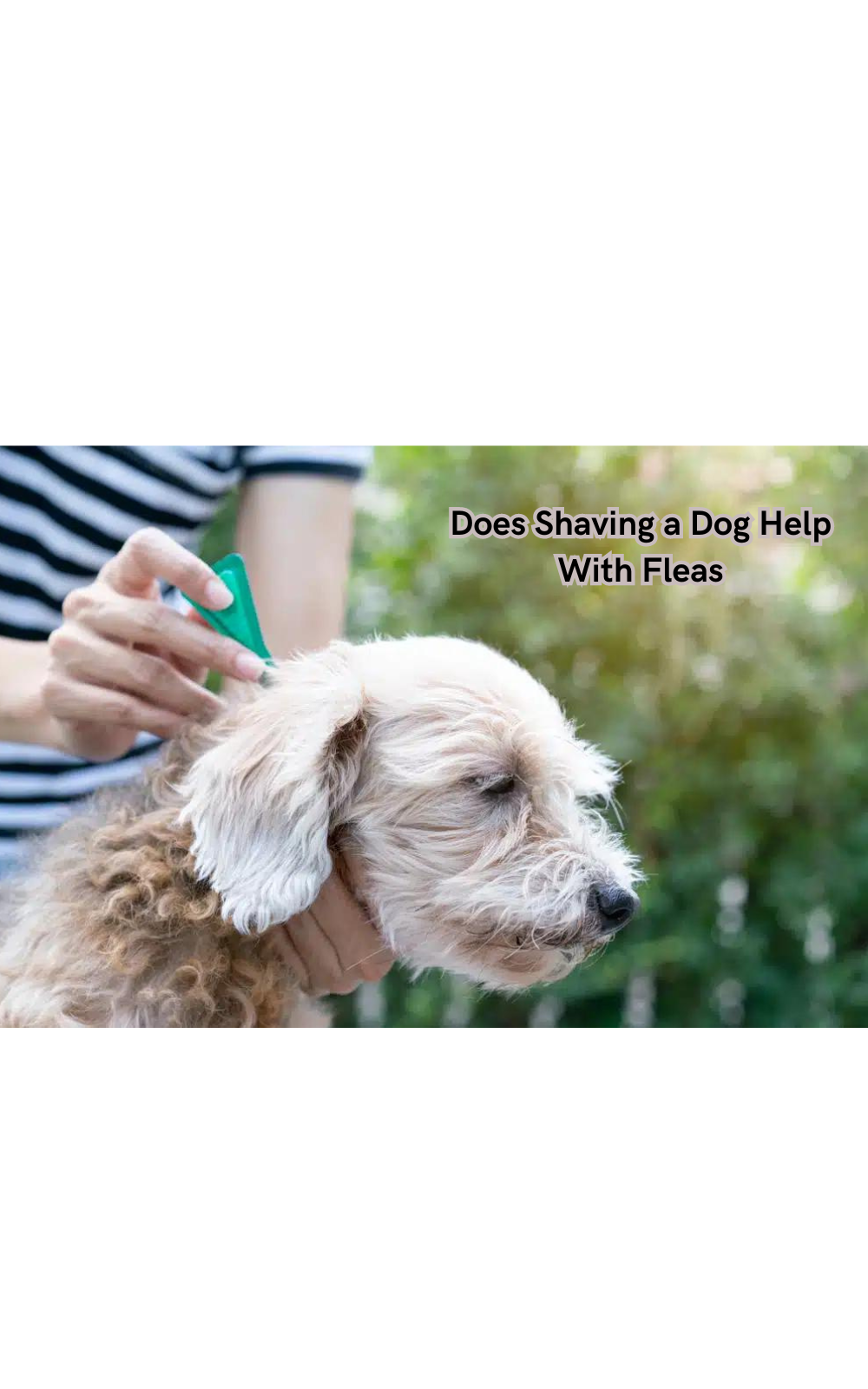Does Shaving a Dog Help With Fleas
This introduction aims to shed light on the misconceptions surrounding dog shaving and emphasize the importance of informed flea control methods for maintaining our pets' health and comfort.

Shaving a dog to address flea infestations is a topic of concern for many pet owners. It's crucial to understand the implications of this practice to ensure the well-being of our furry friends. While some may believe that shaving can help rid a dog of fleas, it's important to debunk this misconception.
Shaving a dog's coat can potentially worsen flea problems and lead to skin irritation. This introduction aims to shed light on the misconceptions surrounding dog shaving and emphasize the importance of informed flea control methods for maintaining our pets' health and comfort.
The Myth of Shaving as a Flea Control Method
Many people believe that shaving a dog's fur can help eliminate fleas. The reasoning behind this belief is that shorter hair will make it easier to spot and remove pesky insects from a dog's coat.
However, this is not entirely true. While shaving may temporarily reduce the flea population on a dog's body, it can have adverse effects in the long run.
Fleas are agile creatures that can easily move between different areas of a dog's body, regardless of hair length. Moreover, shaving a dog's coat leaves their skin exposed and vulnerable to flea bites.
This can lead to intense itching, scratching, and even infection. Additionally, shaving can strip away the natural oils and protective layers of a dog's coat, making them more susceptible to flea infestations.
Understanding the Life Cycle of Fleas
To understand why shaving a dog is not an effective flea control method, it's essential to delve into the life cycle of these tiny parasites. Fleas lay eggs that hatch into larvae, which develop into pupae before emerging as adult fleas.
While adult fleas make up only 5% of the flea population, their remaining stages can be found in different areas of a dog's environment. These stages can lie dormant for months, making completely eradicating fleas from a dog's surroundings challenging.
Shaving a dog does not eliminate these hidden stages, meaning that even if the adult fleas are removed from the dog's body, they can easily be re-infested once exposed to their environment again.
It's also worth noting that fleas can easily attach themselves to a dog's skin and fur, regardless of length. Therefore, shaving a dog may provide temporary relief but does not address the root cause of flea infestations.
Does Shaving a Dog Help With Fleas?
The answer is no. Shaving a dog does not help with fleas and can potentially do more harm than good. Instead, focusing on preventive measures and proper flea control methods is crucial to keep our furry companions free from these pesky parasites.
Regular grooming, using flea prevention products recommended by veterinarians, and keeping the dog's environment clean are all essential steps in managing and preventing flea infestations.
Killing fleas with topical flea treatments or oral medications is a more effective and long-lasting solution than shaving. Kills adult fleas and prevents flea eggs from hatching, breaking the flea life cycle.
Additionally, if a dog is already experiencing intense itching and irritation due to fleas, it's best to consult a veterinarian for appropriate treatment options instead of shaving. Remember, our dogs' well-being should always be our top priority, and informed decision-making is crucial regarding their health.
How to Spot Fleas on Dogs
Now that we've established that shaving a dog is not an effective flea control method, we must know how to identify and address fleas on our furry friends. Here are some signs to look out for:
- Excessive scratching, biting, or licking of the skin
- Red and irritated skin, especially in areas with less hair
- The presence of tiny black or brown specks (flea dirt) on the dog's skin or in their bed
- Visible fleas on the dog's body
- flea allergies are common signs
If you notice any of these signs, taking action immediately is important. Consult a veterinarian for proper flea treatment options and follow preventive measures to keep your dog flea-free. Remember, shaving dogs will not help with fleas and may even cause more harm.
What Fleas Look Like on Dogs
Fleas are tiny, wingless insects that are about the size of a sesame seed. They have flat bodies and can range in color from brown to reddish-brown. Due to their small size, they can be difficult to spot on a dog's coat, but they can often be seen scurrying around or jumping when inspecting for them.
What Is the Fastest Way to Get Rid of Fleas?
If you're dealing with an active flea infestation, it's understandable to want to get rid of them as quickly as possible. However, there is no guaranteed "fast" way to eliminate fleas. It requires a combination of proper treatment for the dog and environment and consistent preventive measures. Some options for addressing a flea problem include:
- Use Topical Flea Medication: These are applied directly to a dog's skin and can kill fleas quickly. However, it's important to consult a veterinarian for the most suitable product for your dog.
- Flea Shampoo: While not as effective as a topical medication, flea shampoos can provide temporary relief from fleas on a dog's coat.
- Keep Your Home Clean: Regularly vacuuming and washing your dog's bedding can help get rid of fleas and their eggs in the environment.
- Professional Pest Control: In severe cases, it may be necessary to seek professional pest control services to eliminate fleas from your home.
- The Groomer or Kennel: If your dog has been around other dogs that have fleas, it's important to get them groomed or bathed promptly.
It's essential to be patient and consistent when dealing with fleas. Getting rid of them completely may take some time, but with the right approach, it is achievable.
How to Prevent Dogs from Getting Fleas
The best way to deal with fleas is by preventing them from infesting our dogs in the first place. Flea preventatives are available in various forms, including topical treatments, oral medications, and collars.
Consult a veterinarian to determine the most suitable option for your dog based on their age, health, and lifestyle. Additionally, here are some other preventive measures to consider:
- Keep your dog's living area clean and vacuum regularly to remove any flea eggs or larvae.
- Avoid walking your dog in areas known for high flea activity, such as tall grass or wooded areas.
- Check your dog's coat regularly for fleas, and use a flea comb to remove them promptly.
- Keep your dog away from other dogs that may have fleas.
- Wash your dog's bedding regularly with hot water.
By following these preventive measures, we can significantly reduce the risk of our dogs getting infested with fleas. Remember, prevention is key when it comes to flea control.
Do Dogs Get Sad When They Get Shaved?
Some people believe that shaving a dog can cause them to feel sad or embarrassed.
However, dogs do not have the same emotional responses as humans, and therefore, they do not experience feelings of sadness or embarrassment in the same way.
While they may initially feel uncomfortable due to a change in their appearance, it is a temporary feeling and does not affect their overall well-being. Double-coated dogs may feel a bit cooler after being shaved, but this can be remedied by providing proper shelter and access to shade during hot weather.
To control fleas or kills fleas, shaving dogs is not the answer. Instead, it's crucial to focus on preventive measures and proper flea control methods recommended by veterinarians.
Remember, our furry friends rely on us to keep them safe and comfortable, and making informed decisions about their health is essential for their overall well-being. So next time you notice fleas on your dog, think twice before reaching for those clippers.
FAQs
Do fleas like long hair or short hair?
Fleas do not have a preference for hair length. They can infest both long and short-haired dogs equally. However, fleas may be more difficult to spot on dogs with longer hair, making them harder to detect and treat.
Will bathing a dog kill fleas?
Bathing a dog will only temporarily get rid of a few fleas on their coat. It is not an effective method for eliminating an active flea infestation. However, using a flea shampoo can relieve and help remove dead fleas from the dog's coat.
Do fleas like dirty fur?
Fleas do not necessarily prefer dirty fur but thrive in warm and humid environments. Therefore, a dirty coat or living area can create an ideal breeding ground for fleas to multiply. Regular grooming and cleaning can help prevent flea infestations. Therefore, keeping your dog clean and their living spaces regularly maintained is essential.
Is flea-free safe for dogs?
Flea treatment products specifically designed for dogs, such as topical medications and flea collars, are safe when used according to the instructions. However, it's important to consult a veterinarian before using any flea control product on your dog, especially if they have any underlying health conditions.
Conclusion
In conclusion, while shaving a dog may provide temporary relief from fleas by removing some of the pests and allowing easier application of flea treatments, it is not a long-term solution or a guarantee of eradication. Fleas can still infest a shaved dog, as they can reside in the environment and on other animals.
Additionally, shaving may expose the dog to sunburn, skin irritation, and vulnerability to other parasites. Addressing flea infestations through comprehensive measures such as regular grooming, vet-recommended flea treatments, environmental control, and maintaining a clean living space is crucial.
